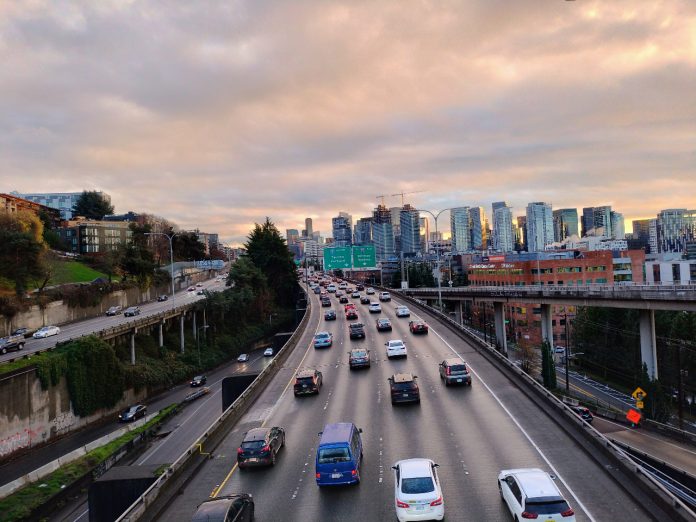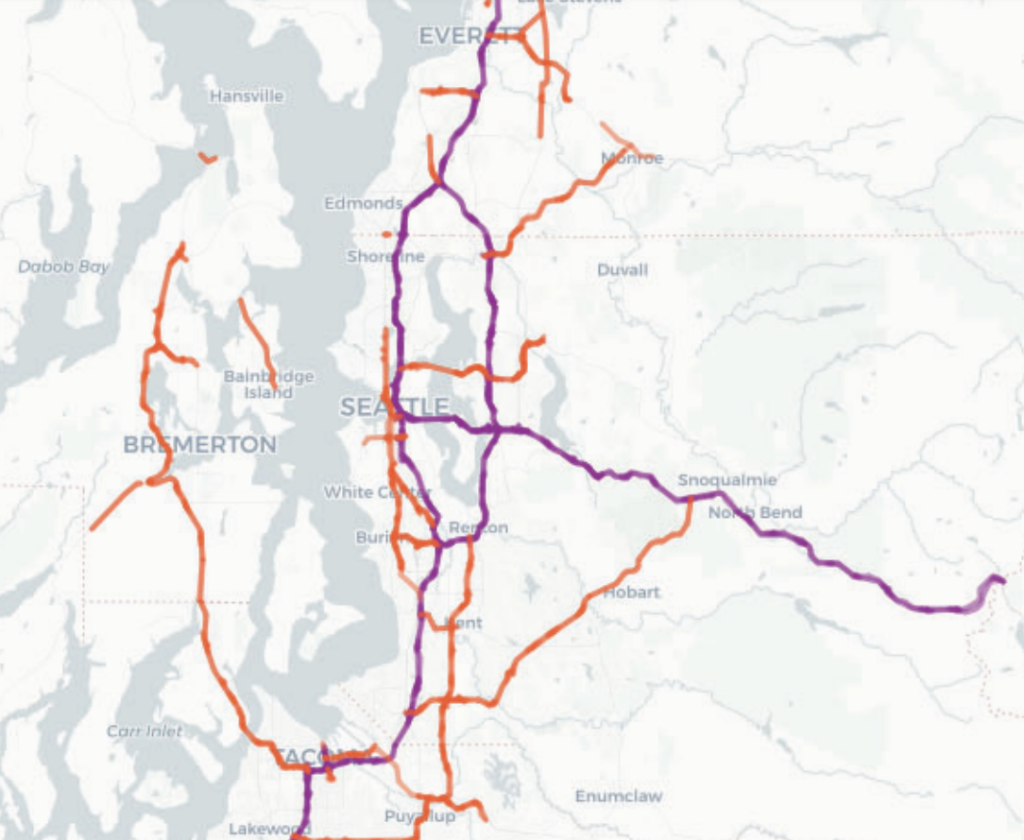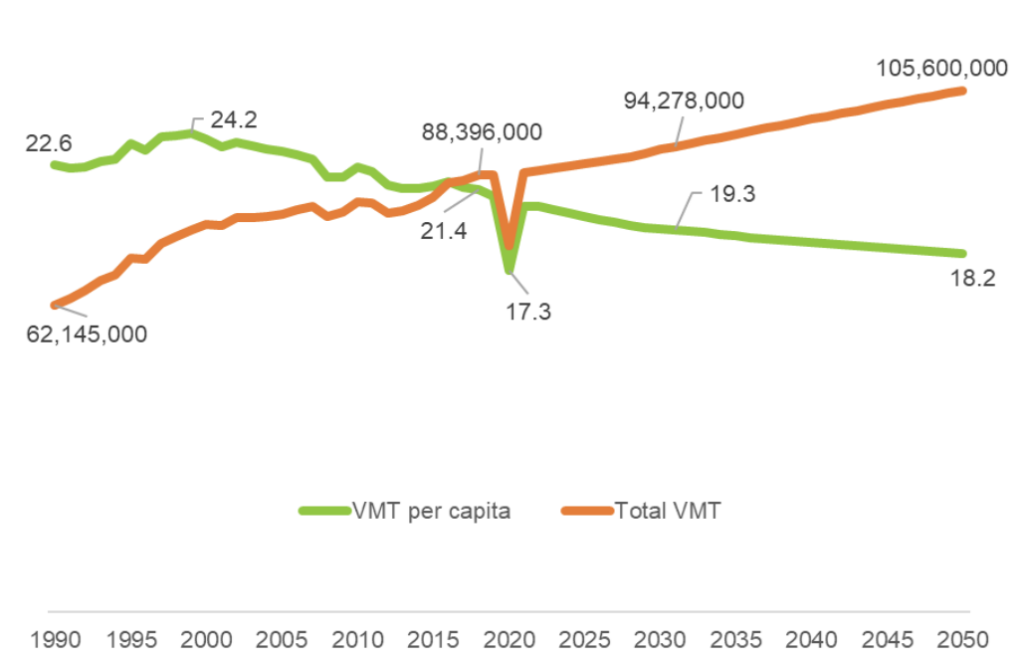
Even in the face of ambitious greenhouse gas emissions goals that remain out-of-reach, elected leaders in central Puget Sound aren’t ready to rethink the process around how federal dollars are used to boost local transportation projects and de-prioritize projects that increase driving and pollution.
This week, members of the Puget Sound Regional Council’s Transportation Policy Board, a group of local elected officials from Pierce, Kitsap, King, and Snohomish Counties tasked with regional planning issues, voted against a proposal to bar transportation projects that would add general purpose vehicle capacity to the region’s limited access highways from competing against other public transit and traffic safety projects for a specific pool of federal dollars, the Federal Highway Administration’s flexible Surface Transportation Program (STP).
The unwillingness of regional leaders to take this relatively small step illustrates the degree to which a region that prides itself on being climate-forward is not ready to take the hard steps to actually make its emissions reduction goals a reality. The next chance to rethink grant prioritization guidelines likely won’t come until 2026. In the end, the vote was fairly decisive, with 15 elected officials voting against the idea, compared to three who supported it.
In December, The Urbanist outlined the proposal, which had been put forward in late fall and had support from a number of local policymakers, including Pierce County Councilmember Ryan Mello and Tacoma Councilmember Kristina Walker. They argued that the region needs to be forward-thinking about which projects get prioritized for investments, with the decisions being made right now now impacting dollars that won’t be allocated until 2027-2028, likely meaning they wouldn’t actually start construction until close to the end of the decade.
The proposal only would have applied to general-purpose capacity projects on the region’s limited-access highways, not surface-running state highways or local arterials. The Washington State Department of Transportation would still have been able to move forward with any expansion projects on those limited-access highways, and local governments would still be able to advance almost any projects they want. The only change would occur would be a repeat of 2022 would be prevented, in which the state-funded expansion of State Route 167 was awarded just over $5 million in STP funding, beating out a transit projects in Seattle and a safety project in Everett.

“The intent of this item is, is to say that we don’t want to use our dollars at PSRC to add general purpose vehicle capacity on state highways,” Mello said this week. “There are other ways to fund those projects on state highways, if the state chooses to do that with their dollars, but we’re saying that our dollars should be focused on limiting vehicle miles traveled, limiting greenhouse gases, improving safety and circulation within our communities… and we don’t do that by adding general purpose vehicle capacity. It is proven that by doing that you actually cause more traffic delay for people, you may get less safe, you have people sit in traffic more.”
The Regional Transportation Plan adopted by PSRC in 2022 projects that per-capita vehicle miles traveled in the region will fall by nearly 15% compared to 1990 levels by 2030, as the four-county area adds new residents who are more likely to take transit or smaller car trips for essential needs. That actually falls short of the goals the state legislature has codified into state law, which call for a 30% reduction by 2035. PSRC’s projections only expect to get to just over 19% reduction by 2050, compared to the 50% goal that the state legislature wants to see achieved by that year.

When it comes to overall transportation emissions, it’s not clear things are even heading in the right direction. While local emissions data remains several years out of date, new national emissions data shows that the transportation sector was the only place the US saw emissions increases between 2022 and 2023, with a 1.6% increase seen, according to research from the Rhodium Group reported this week. PSRC’s own analysis shows that the projects included in the Regional Transportation Plan aren’t enough to enable to region to hit its 2030 goals, but proposals that move too fast when it comes to how funding is allocated usually get strong pushback from local governments.
Pushing back most strenuously on this proposal was Mary Lou Pauly, the Mayor of Issaquah. Pauly, despite governing a Leadership in Energy and Environmental Design-certified city, argued that the region needed to have the flexibility to approve roadway expansion projects, particularly ones that interact with the state highway network.
“I’ll speak specifically to Issaquah, where we know additional ramps and other things are going to be required for the addition of light rail, for over/undercrossings — we don’t have enough in order to be able to manage mobility movements, and so this to me did not seem like a minor modification or something that we could do in the short term,” Pauly said, arguing that the board needed more information to be able to make a full determination of whether it should prioritize expansion of the state highway network. “I don’t know where I am,” Pauly added. “I don’t know if we had more data whether or not I’d be a yes or no.”
Other members of the policy board were open about their belief that the region should be building larger and wider roadways. “I believe that we need to focus on increasing capacity overall and throughput overall and not exclude increasing capacity that does not involve HOV,” SeaTac Councilmember Peter Kwon said. “I believe this is something that would negatively impact not just our city but also the entire region and this should require a lot more thought.”
Speaking in favor of the change at Thursday’s meeting was Matthew Sutherland, advocacy director for Transportation Choices Coalition. “Were excited by the opportunity to further align PSRC’s transportation funding processes with state and regional priorities of equity, safety and climate,” he said. “We should create a floor of some kind that would prevent poorly scoring projects that do not meet our vision priorities from a spot on the contingency list. And we shouldn’t be allowing projects applying for general purpose lane capacity to be eligible for FHWA and CMAQ competitions.”
In the final vote, Mello and Walker were joined by Bainbridge Island Councilmember Leslie Schneider in supporting the proposal, with the rest of the board solidly opposed. In his first meeting at the Puget Sound Regional Council, Rob Saka, the Seattle City Councilmember who was sworn into office just over a week ago, joined the opposition bloc. Seattle Councilmember Dan Strauss, who also serves on the board, did not attend the meeting.
The idea may have more support at PSRC’s Executive Board, which meets later this month, though likely not enough to reverse the transportation policy board’s stance.
“It shouldn’t be controversial to say it’s a bad idea to fund projects that increase traffic and climate pollution. Especially when we could spend the money on making our problems better instead of worse,” Bothell Mayor Mason Thompson posted on social media in December after the idea was put forward.
While Thompson is only an alternate member, at least one full-fledged member of the Executive Board agreed with him.
“The priorities for our region must be: 1) Safety for all users 2) Safety for all users 3) Safety for all users,” Shoreline City Councilmember Christopher Roberts posted in response to the same meeting. “As we prioritize safety, we will also be encouraging more people to walk, ride, and use transit – and address our climate crisis.”
If this week is any indication, aligning those priorities with where the region’s dollars go will be an uphill battle that’s far from won.
Ryan Packer has been writing for The Urbanist since 2015, and currently reports full-time as Contributing Editor. Their beats are transportation, land use, public space, traffic safety, and obscure community meetings. Packer has also reported for other regional outlets including Capitol Hill Seattle, BikePortland, Seattle Met, and PubliCola. They live in the Capitol Hill neighborhood of Seattle.


